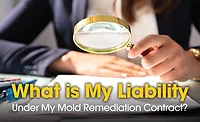Avoiding Legal Liability in Disaster Remediation
Disasters, both man-made and natural, have plagued our safety and security since the beginning of time. The mold crisis of several years ago, combined with a spate of devastating hurricanes and the prospect of bioterrorism, have allowed disaster recovery companies to flourish.

Disasters, both man-made and natural, have plagued our safety and security since the beginning of time. The mold crisis of several years ago, combined with a spate of devastating hurricanes and the prospect of bioterrorism, have allowed disaster recovery companies to flourish. New companies drawn into this industry by the relatively low cost of entry and the high potential rewards may not have the skill or experience necessary to perform the tasks required. Danger and risk are always present whenever a contractor ventures outside of his or her established areas of expertise.
While the opportunity to develop a profitable and successful company exists, one uninsured claim is all it takes to put an otherwise “healthy” company into bankruptcy. Knowledge, good advice and sound judgment are needed to minimize the risk inherent in each project.

Governo
Remediation and Cleaning Liability
Most legal claims in the remediation and cleaning industry fall into two categories: breach of contract and negligence. From a legal perspective, the key questions usually are, “What did the contractor have a duty to do?” and “Did the contractor perform his duty?” Typically, the scope of a contractor’s duty is found in the contract with the customer, but often terms are not clear. Perhaps the scope of the project was left intentionally vague because the emergency nature of the disaster made it impossible to know what needed to be done. What does a “workman-like manner” mean? In many cases, factors outside the specific contract, such as the “standard of care” for the particular industry, environmental regulations, etc., are triggered.Training and expert advice on compliance with legal requirements can help cleaning and restoration contractors manage the risk of liability. Trade associations, private companies, and even governmental agencies conduct educational and training programs to help contractors learn about and comply with the applicable laws and regulations. It is often best for a contractor to consult a qualified expert in the field to be assured that he complies with his obligations for a particular project. Remember, it is easier and less expensive to stay out of trouble than it is to get out of trouble.

Rhein
Overview of Law Regarding Mold Remediation
Despite controversy regarding the actual health effects of mold exposure, there is no question that mold causes physical symptoms and property damage. Mold-related lawsuits are expensive to defend and insurance coverage for mold has diminished. Contractors who perform mold remediation work must be concerned about protecting their assets and minimizing the risks associated with this type of work. These goals are accomplished by:- Legal planning for asset protection.
- Purchasing the proper insurance coverage, and
- Using and documenting appropriate mold cleanup and prevention techniques (i.e. doing your job properly). Obtain professional legal and insurance advice to protect yourself.
There are no federal standards or regulations established for mold remediation work per se. There are, however, many requirements for related tasks, such as the use of chemicals, the incidental disruption of asbestos and use of proper protective equipment. Texas has established a licensing system for mold assessors and remediators, and training course accreditation standards. Other states have not enacted legislation or regulations, but have taken other steps to deal with the public’s concerns. For example, Delaware has granted its State Housing Authority broad powers to respond to “unsanitary” conditions by ordering abatement and by declaring premises unfit for habitation. It is crucial to obtain up-to-date guidance on the relevant laws, regulations, and practices in your jurisdiction.
Private entities have set industry standards in the area of mold remediation. For example, the Institute of Inspection, Cleaning and Restoration Certification developed two important standards, the “S500 Standard and Reference Guide for Professional Water Damage Restoration” and the “S520 Standard and Reference Guide for Professional Mold Remediation.” The IICRC states these standards set a comprehensive level of professional care, enabling remediators to deal with uncertainties associated with particular water-loss issues.
Other mold remediation guides include the New York City Health Department’s guidelines and EPA’s “Mold Remediation in Schools and Commercial Buildings.” These guides outline the levels of abatement, discuss the importance of correcting the underlying moisture issue, and recommend personal protective equipment for use at the job site. OSHA’s “A Brief Guide to Mold in the Workplace” provides recommendations for the prevention of mold growth and describes mold remediation plans and cleanup methods. OSHA’s Personal Protective Equipment standards require employers to ensure, among other things, that workers use appropriate eye and face protection and that workers are given protective clothing and respiratory devices when such equipment is necessary to protect their health.
Avoiding Potential Pitfalls
Even if you perform your work flawlessly and provide the best customer service, odds are that, over time, you will be sued. Lawsuits typically arise when customers’ expectations vary from their perception of the work performed. Reduce the risk of lawsuits by knowing the state-of-the-art for your industry and by paying attention to the customer.Poorly written contracts increase the risk of lawsuits. Since this is one area you have control over, be sure your contracts are sound. As a preliminary matter, have a clear understanding of who the client is. A homeowner or condo association may hire you, but an insurance company may pay you. To whom do you owe a duty? Typically, the duty is to the person who hired you. Given the role of insurance in this industry and the allegiance contractors have with insurers, the legal duties in this area are often ignored, opening up the contractor and insurer to liability.
Customers undergoing a stressful event often will not clearly understand their needs or what you will provide them. Explain as carefully as possible what tasks you will perform, what materials you will use, how long it will take and, to the extent possible, the situation the customer will be in when you leave. Be sure the customer understands what property will be retained and discarded. Have customers sign your documents to prove their assent. As the job progresses, document the work you perform. Clear communication is the key to avoiding disputes.
One of the quickest ways to create liability is to perform the same task differently each time you do it. As soon as one job goes wrong, the other jobs you performed in a different manner will provide ample evidence of a deviation from your own “standard of care,” ensuring that liability will follow. Operations manuals, contracts and forms help you and your employees concentrate on the task at hand by establishing a routine that allows both an effective process and sound legal protection. It is important to have set procedures and protocols based on industry standards, but it is even more important to make sure to follow the standards you adopt.
Although clearly communicating the work you will perform is a key ingredient in protecting your company, properly responding to customers’ complaints is another important opportunity to reduce legal liability. A customer’s perception that you are making every attempt to correct a problem reduces the risk of a claim. Timing is key. Respond to complaints right away and deal with customers in a straightforward manner. Beware, however, of admitting liability or making statements that will later be held against you. Train your employees to handle complaints professionally. Encourage laborers to call for assistance in responding to customers’ complaints. Put employees through mock complaint training sessions that test and hone their skills.
Although poor contracts can cause trouble, generally a company’s employees are the culprits when it comes to lawsuits. Diligence in the hiring process is helpful, yet it is training that helps assure the service provided is as anticipated. Periodic training is particularly crucial, as remediation techniques and technology tend to change over time.
Finally, one of the easiest ways to avoid a certain percentage of legal problems is to avoid taking jobs for high-risk customers. These are potential customers who, through their questions and demeanor, make you wonder whether the job is going to be worth the effort. If the customer is asking you to restore the “un-restorable,” or otherwise poses what you perceive as a “litigation risk,” consider declining the job.
Crime Scene Remediation
Crime and trauma scene remediation is a specialized market within the remediation world. These settings require the cleanup of biological contamination (e.g. blood) or chemical contamination (e.g. chemicals at a methamphetamine lab). Crime and trauma scene contamination often cannot be removed using normal cleaning techniques and supplies. Unless trained professionals are hired to properly perform the job, significant health risks to both the public at large and the employees attempting the cleanup can remain.Despite the risks of harm, crime scene remediation is practically an unregulated industry. There are no federal regulations, and only California and Louisiana have state legislation in this specific area. However, OSHA categorizes all bodily fluids as biohazards and permits are required to handle, transport and dispose of biohazardous waste. OSHA’s Bloodborne Pathogen Standards are directives for handling biohazardous material. 29 CFR 1910.1030; this regulation states that before an employee can be involved in cleanup or exposed to biohazardous waste, the employer must first:
- Provide blood-borne pathogen (BBP) training.
- Establish a written exposure control plan.
- Provide appropriate personal protective equipment (PPE).
- Make the Hepatitis B vaccine available, and
- Provide a method to remove and properly store biohazard waste from contaminated site.
Additionally, crime scene remediation firms must comply with state and local environmental regulations concerning the disposal and handling of biohazardous materials. Much of the state level regulation regarding handling these materials can be found in the sections dealing with medical waste.
Conclusion
Man-made and natural disaster remediation projects, like all construction projects, present unique challenges. A combination of common sense, training, experience and professional judgment can help identify the proper methods, protection, and steps to take in each particular situation. Awareness of the nature and scope of the relevant laws, regulations and industry standards helps protect contractors from liability. Your financial well-being depends on performing the duty you have in a manner consistent with your industry’s standard of care. Understand your obligations, comply with the requirements, and document your compliance. Taking these steps is the key to protecting yourself at all times. If you liked this feature circle 134 on page 51.Looking for a reprint of this article?
From high-res PDFs to custom plaques, order your copy today!




